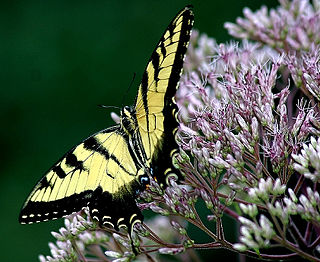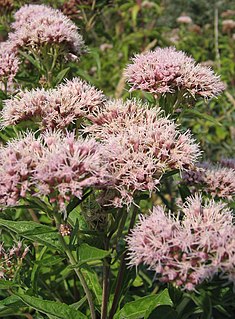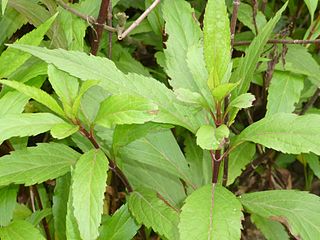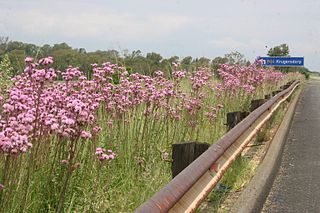
Eutrochium fistulosum, also called hollow Joe-Pye weed, trumpetweed, or purple thoroughwort, is a perennial North American flowering plant in the sunflower family. It is native to southern Canada and throughout the eastern and south central United States from Maine west to Ontario, Wisconsin, and Missouri and south as far as Florida and Texas. The specific name fistulosum refers to the tubular stem; see fistula.

Choy sum is a leafy vegetable commonly used in Chinese cuisine. It is a member of the genus Brassica of the mustard family, Brassicaceae. Choy sum is a transliteration of the Cantonese name, which can be literally translated as "heart of the vegetable". It is also known as Chinese flowering cabbage.

Ageratina altissima, also known as white snakeroot, richweed, or white sanicle, is a poisonous perennial herb in the family Asteraceae, native to eastern and central North America. An older binomial name for this species is Eupatorium rugosum, but the genus Eupatorium has undergone taxonomic revision by botanists, and a number of the species that were once included in it have been moved to other genera.

Eupatorium is a genus of flowering plants in the aster family, Asteraceae, containing from 36 to 60 species depending on the classification system. Most are herbaceous perennials growing to 0.5–3 m (1.6–9.8 ft) tall. A few are shrubs. The genus is native to temperate regions of the Northern Hemisphere. Most are commonly called bonesets, thoroughworts or snakeroots in North America. The genus is named for Mithridates Eupator, king of Pontus.

Eupatorium cannabinum, commonly known as hemp-agrimony, or holy rope, is a herbaceous plant of the daisy family. It is a robust perennial native to many areas of Europe. It is cultivated as an ornamental and occasionally found as a garden escape in scattered locations in China, the United States and Canada. It is extremely attractive to butterflies, much like buddleia.

Astilbe chinensis, commonly known as false goat's beard, tall false-buck's-beard or Chinese astilbe, is a plant in the saxifrage family, Saxifragaceae. It is commonly grown in shade gardens.

Eutrochium maculatum, spotted joe-pyeweed, is a North American species of flowering plant in the sunflower family Asteraceae. It is widespread through much of the United States and Canada. It is the only species of the genus Eutrochium found west of the Great Plains.

Eupatorium hyssopifolium, also known as hyssopleaf thoroughwort, is a fall-blooming herbaceous plant native to North America. Like other members of the genus Eupatorium it has inflorescences containing a large number of very small flower heads, each with 5 white disc florets but no ray florets. At 0.5 to one meter tall, it is towards the shorter end of the range of heights found in Eupatorium species.

Eupatorium album, or white thoroughwort, is a herbaceous perennial plant in the sunflower family native from the eastern and southern United States, from eastern Texas to Connecticut, inland as far as Indiana.
Eupatorium compositifolium commonly called Yankeeweed is a North American herbaceous perennial plant in sunflower family native to the southern United States. Like other members of the genus Eupatorium it has inflorescences containing a large number of small, white flower heads, each with 5 disc florets but no ray florets. The plant is 0.5 to 2 metres tall.
Eupatorium lancifolium, commonly called lanceleaf thoroughwort, is a North American herbaceous perennial plant in the sunflower family native to the south-central United States.
Eupatorium leptophyllum, commonly called false fennel, is a herbaceous perennial plant in Asteraceae native to the southeastern United States from Mississippi to the Carolinas. Like other members of the genus Eupatorium, it is about one to two meters tall and has inflorescences containing a large number of tiny white flower heads, each with 5 disc florets but no ray florets. E. leptophyllum grows in wet areas and can grow in shallow water, often at the edges of ponds.
Eupatorium leucolepis, commonly called justiceweed or white-bracted thoroughwort, is a herbaceous perennial plant in Asteraceae native from the eastern coastal United States, from New York to eastern Texas, with scattered populations inland as far as Kentucky and West Virginia.

Eupatorium mikanioides, commonly called semaphore thoroughwort, is a herbaceous perennial plant in Asteraceae found only in the US state of Florida.

Eupatorium mohrii, commonly called Mohr's thoroughwort, is a herbaceous perennial plant in Asteraceae native to the southeastern and south-central states of the United States, in the coastal plain from Virginia to Texas. It has also been found in the Dominican Republic.

Eupatorium sessilifolium, commonly called upland boneset or sessile-leaved boneset, is a North American plant species in the sunflower family. It is native to the eastern and central United States, found from Maine south to North Carolina and Alabama, and west as far as Arkansas, Kansas, and Minnesota.

Eupatorium fortunei is a plant species in the family Asteraceae native from Asia where it is rare in the wild but commonly cultivated. The white to reddish colored flowers and herbage smell like lavender when crushed. In China the plants are used to make fragrant oils.

Eupatorium japonicum, known as fragrant eupatorium in English and 白头婆 bai tou po, in Chinese, is a herbaceous plant species in Asteraceae. It is native to China, Japan and Korea.

Eupatorium macrocephalum Less. aka pompom weed, is a cosmopolitan perennial plant belonging to the family of Asteraceae and regarded as an invasive weed in some countries. It is native to the southern United States, Central America, South America and was introduced to South Africa. It is classed as a principal weed in Brazil. In South Africa it has been cultivated as an ornamental, is often found on roadsides, and has become of concern for its invading of undisturbed climax grassland and wetlands since the 1960s. It is closely related to Siam weed, and is one of some 268 species in the genus.
Eupatorium novae-angliae, commonly called New England boneset, New England justiceweed or New England thoroughwort, is a rare and endangered North American species in the sunflower family. It is found only in 4 counties in southern New England. The species is listed as endangered species in both states.















